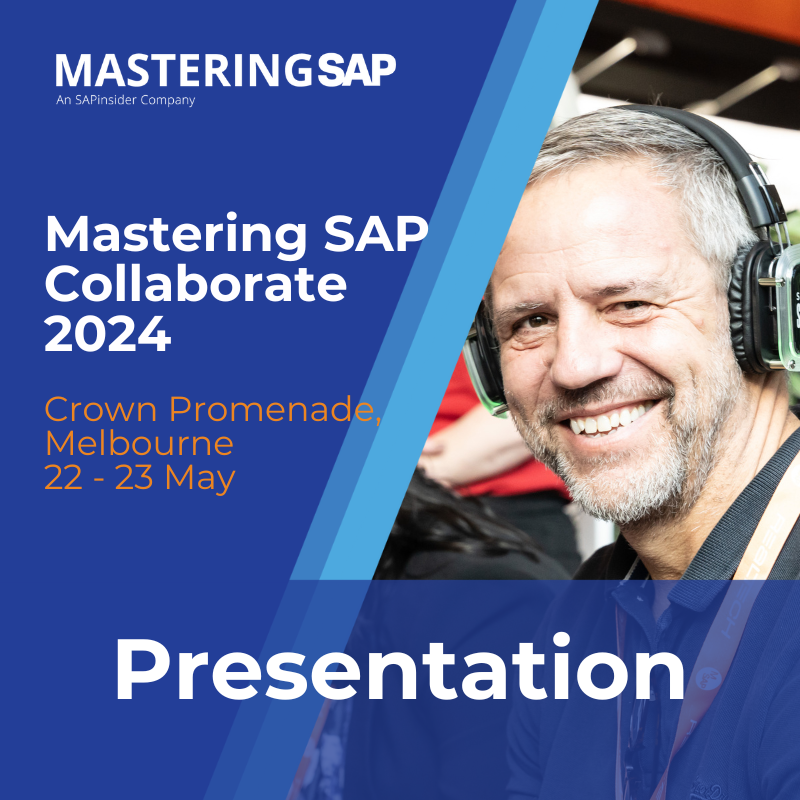Live from SAPinsider Studio: Ty Miller of SAP on Cloud for Analytics
Ty Miller, Vice President, Product Management, SAP Analytics, joins SAPinsider Studio at the 2016 BI-HANA-IoT event to discuss SAP Cloud for Analytics. Topics of this discussion include the Cloud for Analytics roadmap for predictive and exploratory analytics, Cloud for Analytics for Planning, and what SAP’s acquisition of Roambi means for Cloud for Analytics.
This is an edited version of the transcript:
Ken Murphy, SAPinsider: Hi, this is Ken Murphy with SAPinsider, and I’m at the SAPinsider BI-HANA-IoT event. This morning, I am pleased to be joined by Ty Miller who is the Vice President of Product Management for SAP Analytics. Ty is here to talk to us today about SAP Cloud for Analytics. Ty, thanks for being with us.
Explore related questions
Ty Miller, SAP: Thank you Ken.
Ken: You were a co-presenter at the keynote address yesterday and you had a very well-received demo on SAP Cloud for Analytics where you brought in some extraterrestrial tracking – can you tell the audience a little bit about that?
Ty: Exactly, well we realized that part of the reason we’re creating Cloud for Analytics is for it to be fun. I mean it’s obviously business software to help users make better decisions based upon actual data. But we also realized that we want to build analytics that is fun to use and so we decided to look for some data and a story that was fun in and of itself. It wasn’t specific to a line of business, or to an industry that everyone would kind of understand. So we kind of stumbled upon this mutual UFO and network dataset and being in the location of Las Vegas with some interesting characters around it kind of made for a good story to tell and a way to show off Cloud for Analytics.
Ken: Two of the things that jumped out at me were the variety of data sources that you brought in – seemingly data from everywhere. And the other thing was that it seemed that once you dig in you’re asking new kinds of questions, right, so it sort of flows. Can you discuss that?
Ty: Yes, it’s very iterative. And this is really what we’re finding more sophisticated users want to do; they’re not satisfied with just seeing answers to their questions that are already available in a dashboard or report. They’re curious, inquisitive, and they want to go out and do more analysis and investigation. So this is exactly one of the reasons why data discovery has come into the fore. That experience in Cloud for Analytics is very much at the center of it. And obviously an important ingredient for being able to do data exploration is being able to connect to lots of data. And we’re just at the beginning of that for Cloud for Analytics where yes we can connect to Excel spreadsheets, CSV files, Google Sheets, and then more enterprise types of data whether it’s Smart Data Integration or Smart Data Access for traditional relational sources, or streaming data, or HANA, or BW – but there’s a lot more data that we’ll be bringing into Cloud for Analytics as well.
Ken: I wanted to ask you about exploratory analytics vs. predictive. Was that something we saw in the demo?
Ty: We didn’t yet – it’s something I’ll be showing later today in a focus session; exploratory analytics is essentially predictive capabilities for the business analyst rather than predictive analytics for the data scientist. So exploratory analytics is much more of a business person focused capability and it’s something that we’re looking to build into Cloud for Analytics and to release sometime around the middle of the year. So we’re working on it now and it’s a really burgeoning and exciting part of the analytics environment. So we’ll see more of that coming soon.
Ken: So that will be brought out when predictive is rolled into Cloud for Analytics?
Ty: Correct. So Cloud for Analytics is built on top of HCP, HANA Cloud Platform, and within the HANA Cloud Platform we just released our predictive services for HANA Cloud Platform and it’s on those predictive services that we’re building the user interface of exploratory analytics. So we’ve already started the groundwork, the plumbing is there and now we want to build the user experience.
Ken: You touched on the business analyst. For the business analyst or end user of Cloud for Analytics it seems that this opens the door for new ways to look at your data. What does a company do to change how they look at analytics if they’re using this solution?
Ty: A few things. One, they have to really buy into the fact that decisions should be made based on facts and not just gut feel. And that comes from a top level down focus on analytics. No. 2 is that executive management has to invest in analytics and that means investing both in solutions but also people; people often need to be enabled to use solutions that are required for them. So that’s probably the most important aspect is to have a focused strategy for and investment in people and solutions to use analytics.
Ken: And the integration – I understand clearly it integrates with SAP S/4HANA, so if you’re doing planning and consolidations in S/4 you can use Cloud for Analytics ….
Ty: Coming. The integration with S/4HANA is right around the corner.
Ken: So what if you’re doing planning and consolidations on-premise?
Ty: Essentially if customers have BPC today, BPC running on BW or HANA or analysis services, they can use that with Cloud for Analytics for Planning. And so we have a bi-directional integration with BPC so we can import a BPC model into Cloud for Analytics, where then a Cloud for Analytics for Planning user can do their additional allocations and spreading and planning within Cloud for Analytics and then they can push that back into BPC for the even more detailed and richer planning capabilities that exist in the on-premise solution. So it’s a very good symbiotic relationship between the two – Cloud for Analytics for Planning is very much a complementary solution to BPC it’s not meant to replace it.
Ken: I don’t know if it’s for developing apps to track extraterrestrials but are companies today using HANA Cloud Platform to build apps specific for Cloud for Analytics?
Ty: They’re just starting. Right now the integration we have with HCP is more as a data source; HANA on-premise, HANA on HANA Enterprise Cloud and HANA on HANA Cloud Platform are all instances of HANA that we can connect Cloud for Analytics to as a data source. The HCP team is working on making services available within HCP to create custom applications as well, and that’s definitely something we want to move to more in the future and have those public APIs to allow the community whether it’s our partners or individuals or organizations want open source capabilities to really create an ecosystem of applications with HCP being that platform to enable that.
Ken: And then lastly the announcement of the acquisition of Roambi. Does that create another way to distribute apps for Cloud for Analytics on a mobile device?
Ty: It does. Roambi has some fantastic technologies, user interfaces, and ways they’ve approached the mobile delivery of content and so we’re just now working with their development and product management teams to look at some of the really innovative ways that they’ve adopted the mobile capabilities and we’ll be looking to see how we can take advantage of that in all of our mobile assets for both on-premise and cloud.
Ken: Ty, thanks for joining us today.
TY: Thank you very much Ken.







